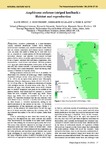Amphiesma stolatum (striped keelback): Habitat and reproduction
| dc.contributor.author | Pryce, D | |
| dc.contributor.author | Thorpe, Christopher | |
| dc.contributor.author | Kulkarni, S | |
| dc.contributor.author | Lewis, T | |
| dc.date.accessioned | 2019-06-25T05:15:34Z | |
| dc.date.available | 2019-06-25T05:15:34Z | |
| dc.date.issued | 2016-06-21 | |
| dc.identifier.uri | http://hdl.handle.net/10026.1/14423 | |
| dc.description.abstract |
Amphiesma stolatum (Natricinae) is a non-venomous Asiatic colubrid distributed widely from Pakistan, eastward into Southern Asia, northward into south China and on various mainlands and islands across Southeast Asia. In India, the snake is found up to 2000 feet (610 m). A. stolatum is a small species (to 90 cm total length), terrestrial, diurnal, and inhabits well-watered lowland plains, forests, hills, rice paddy, agricultural and rural areas. It has a typical natricine diet and hunts amphibians, fish, invertebrates, small lizards and rodents. Females produce 5-15 eggs per clutch throughout active parts of the year and may also attend clutches. The snake aestivates during hot weather and is more frequently observed during rainy seasons (Whitaker & Captain, 2004). | |
| dc.language.iso | en | |
| dc.publisher | British Herpetological Society | |
| dc.title | Amphiesma stolatum (striped keelback): Habitat and reproduction | |
| dc.type | journal-article | |
| plymouth.issue | 136 | |
| plymouth.journal | The Herpetological Bulletin | |
| plymouth.organisational-group | /Plymouth | |
| plymouth.organisational-group | /Plymouth/Faculty of Science and Engineering | |
| plymouth.organisational-group | /Plymouth/Users by role | |
| dcterms.dateAccepted | 2016-01-30 | |
| dc.rights.embargoperiod | Not known | |
| rioxxterms.licenseref.uri | http://www.rioxx.net/licenses/all-rights-reserved | |
| rioxxterms.licenseref.startdate | 2016-06-21 | |
| rioxxterms.type | Journal Article/Review |


